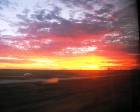Trip ReportCalifornia Zephyr
|
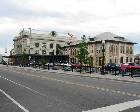
|
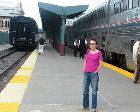
|
Dave has delivered a copy of the Sunday Denver Post to our room. Marie, a baseball junkie, quickly checks the scores and standings and is thrilled to see that our beloved Phillies put one in the win column the night before (we will be seeing the Phils play the Giants in San Francisco in two days). The Post also has the Sunday New York Times crossword puzzle, another of Marie's passions. That is worth another hour or so of puzzle pleasure for her.
At about 8:15am, 10 minutes late, the train horn sounds and we pull out of Denver Union Station and head onto the Union Pacific's former Denver, Rio Grande & Western line to Moffat Tunnel and Salt Lake City. The UP will be our host for the rest of our trip west. Our route takes us northwest out of the city and we begin the steady 4000-foot climb to the Continental Divide. This route is often described as the most scenic Amtrak has to offer and there is no argument from me on that. It is as spectacular today as it was 42 years ago. In 1963 the route left the influence of Denver quickly, but today Denver has spread in all directions and now we ride through fashionable suburbs well into the foothills. Soon the houses end and the real climb begins with a series of twists and turns that match the contours of the ridges. In the Rocky Flats area a string of hopper cars loaded with stone are permanently set on a curve next to the main to provide a wind break in this natural wind funnel.
The elevation rises and the train punches through tunnel after tunnel: some a just a hundred feet or so in length: some considerably longer. The tunnels are often followed by cliff-side vistas with shear drops of hundreds of feet. At several points the train hugs the edge of a ridge with simply spectacular views back toward Denver and the plains to the east. The ride is beautiful. I am glued to the window.
At long last our northerly serpentine course turns westward toward peaks of the Continental Divide. The plains and Denver are left behind and we are in the full grasp of the Rocky Mountains. The vegetation changes from the scrub of the high prairie to the forest of the mountains. Creeks at one moment are hundreds of feet below and the next moment are right next to the tracks. Just a few miles ahead is the Moffat Tunnel and the Divide. At just over 9200 feet elevation, the Moffat Tunnel is the highest point reached by any mainline passenger train in North America. An announcement is made to not pass between cars while in the tunnel, and with the white peaks of the divide looming directly above, we reach the east portal and plunge into Moffat. We have left the influence of the Atlantic and when daylight is seen again we will be in the drainage area of the Pacific Ocean.

|
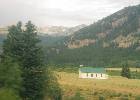
|
The Moffat Tunnel is 6.2 miles long and is traversed in about 15 minutes. When we emerge at the other end we are in the lush, green windward side of the Divide. This is a mountain-rimmed valley belying the fact that it is at a 9000-foot elevation. The Winter Park ski area is here and a few minutes later we make our first stop west of Denver at Frasier. For the next several hours we will slowly descend from the high, lush country of the western divide to the dry intra-mountain basin area. Following first the Frasier and then the Colorado Rivers, the slow, twisting route is through ranch land, rocky canyons, and prairie with mountains bordering on all sides.
At Gramby we stop and our dinner companions from the night before leave for their trip to Rocky Mountain National Park. With US 40 tagging along, we pass through the town of Kremmling where a small plane lands on the airstrip right next to the train. After Kremmling, US 40 heads north toward Steamboat Springs, and we follow the river due west into Gore Canyon. The Colorado River, squeezed by shear rock cliffs, is in its full glory with wild waterfalls and raging rapids. This area is only accessible by river raft and train. The train snakes along on a rocky perch above the river with the ever-present rock slide fencing evidence of the precarious stability of the geology of the area. Each turn reveals another new view of the river. Leaving Gore, the canyon widens into a valley and the river quiets. Now float trips and picnickers replace rapids-shooting daredevils as our companions.
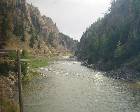
|
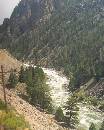
|
The open-seating lunch call comes as we meander along the Colorado River in the highway-free back country. We dine with a couple from England who are making a visit to the US to first see a James Taylor concert in Denver and then take this train ride. They love the train and the distinctly non-English countryside of Colorado, but are bemused by the odd salute give to the Zephyr by the rafters on the nearby Colorado. The rafters find a need to "moon" the train as it passes. This "R" rated attraction (or at least "PG13") is epidemic for several hours and is a new wrinkle since 1963. I have to say I find it just a bit silly and, if I had small kids in tow, might also find it a more than a bit objectionable. But it has been going on long enough that train crews call this section of the Colorado "Moon River" and realistically there is no way to stop it.
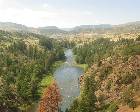 Lunch for us is an Angus beef burger (wife) and a chicken sandwich (me) plus the ever popular Pepsi line of soft drinks (Amtrak is a Pepsi beverage outlet: don't ask for Coke). Once again the food and service is good and the view of the passing Colorado countryside is great. Shortly after lunch we pass Dotsero, the junction with the original Rio Grande line through Colorado across now idled Tennessee Pass (Dotsero named after the zero mile mark of the cut off). This is also the end of the secluded back country scenery. Interstate 70 now shares our route with trucks, cars and RV's.
Lunch for us is an Angus beef burger (wife) and a chicken sandwich (me) plus the ever popular Pepsi line of soft drinks (Amtrak is a Pepsi beverage outlet: don't ask for Coke). Once again the food and service is good and the view of the passing Colorado countryside is great. Shortly after lunch we pass Dotsero, the junction with the original Rio Grande line through Colorado across now idled Tennessee Pass (Dotsero named after the zero mile mark of the cut off). This is also the end of the secluded back country scenery. Interstate 70 now shares our route with trucks, cars and RV's.
Next up is the spectacular trip through Glenwood Canyon and the stop at Glenwood Springs, a smoking stop. With Interstate 70 benched on one wall, and the UP tracks on the other, Glenwood Canyon, a shear-walled rock cut sculpted by the Colorado River over thousands of years, is a scenic wonder. The unique topography of this location, with nearly vertical walls of over 1000 foot height, was the original inspiration for the design of the Vista Dome car in the 1940's. For years a monument was located in the canyon beside US 6. It displayed a miniature vista dome car commemorating the railroad significance of Glenwood Canyon. On the 1963 Zephyr, the presence of the dome car monument was proudly announced by the train crew as we passed on the opposite bank of the river. The monument is long gone from Glenwood Canyon today, a victim of neglect, vandalism, and Interstate 70's obliteration of US 6. It was rescued from the trash heap by the Colorado Railroad Museum in Golden where it was restored and stands today. The monument may be history, but the canyon is still the same spectacular scenic wonder even as it is now passed without onboard fanfare.
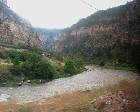
|
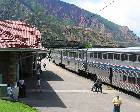
|
Arrival at Glenwood Springs is at 2:10pm, only about 20 minutes late. A smoking stop, we take a walk back to the station building on a brilliant, warm Colorado Sunday afternoon. The Zephyr does a brisk business at Glenwood Springs and the nearby hot springs resort is just a short walk away. We grab some more pictures (don't we all love digital photography), and with the sounding of the horn, reboard the train. Just west of town we have a short delay for an eastbound train. It is Amtrak #6, the eastbound Zephyr that left California the day before. That train left Emeryville just a couple of hours ahead of our Chicago departure and is due into Chicago just minutes after we are due into Emeryville. In a real sense the passing of the two August 20 Zephyrs marks the half way point of our trip.
Western Colorado is an arid, rocky land: a stark contrast to the lush, green forests of the west slope of the divide. I am once again tracing the train route on TopoUSA and noticed the steady drop in elevation. We have lost all the elevation we gained climbing to the divide and are now lower in elevation than Denver. We are also in more open country so the track routing is straighter and the train is moving at speeds that rival the vehicles on the neighboring Interstate. We reach Grand Junction, the major town of Western Colorado, at 4:00pm, 10 minutes early. This is another smoking stop, so off the train I go once again. A fruit stand set up on the platform by local growers is well patronized by both the passengers and the train crew.
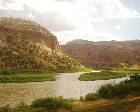 Shortly after leaving Grand Junction, we pass through Ruby Canyon, another area where the train and rafting are the only means of access. At the end of the canyon the Colorado River, our trackside companion for over 200 miles, heads southwest for its encounters with the Grand Canyon and the Gulf of California. We head northwest into Utah: our fifth state of the trip. Another visit from Donna secures a 7:30 dinner reservation for tonight's gastronomical festivities.
Shortly after leaving Grand Junction, we pass through Ruby Canyon, another area where the train and rafting are the only means of access. At the end of the canyon the Colorado River, our trackside companion for over 200 miles, heads southwest for its encounters with the Grand Canyon and the Gulf of California. We head northwest into Utah: our fifth state of the trip. Another visit from Donna secures a 7:30 dinner reservation for tonight's gastronomical festivities.
With a second dinner imminent and looking for all the world like someone who had not showered since Saturday morning (for good reason), I decide to throw caution to the wind and use the shower built into our bedroom's toilet area. I carefully read the instructions, secure the shower curtain in place, and make sure I know precisely the proper workings of the goofy valve setup. With soap and shampoo in hand, let the water flow. It is a bit of a circus act, and is more like washing up with short squirts from a garden hose than a real shower, but it works and I emerge proud of my 79 mph acrobatic achievement and my greatly improved appearance for dining.
Shortly after our next smoking and walking stop at Helper, the 7:30 dinner call is made and we head back to the diner and are seated with a couple visiting from Japan. Our companions are delightful. She has only a very slight knowledge of English, and he can speak some English. But language is not a barrier to communications as we soon talk at length about their trip and ours. They are both enthralled with the American countryside. Similar to the observations of the English couple at lunch, they are amazed by size and the contrasts of our continent, from lush forest to desert, from table-flat plains to awe inspiring mountains. And, yes, our new Japanese friends are photography addicts. With 200 photographs already stored since boarding the train in Denver, he adds at least 20 more before and during dinner. People are really not that different.
For dinner, my wife chooses the catfish, and I have the rotisserie chicken with another split of red wine. Ice cream and chocolate sauce finish off the dining. Both the meals and wine are very good. While dining, the four of us enjoy a spectacular sunset crossing of the Wasatch Range at Soldier Summit. The Wasatch Mountains are the forgotten scenic wonder of Zephyr, lost between the praise given to the Rockies and the Sierras. But this sunset high in Utah mountains is as good as it gets. This is the dining highlight of the trip: simply a wonderful dinner with friendly companions and an unsurpassed view.
Dinner is over and darkness has overtaken the train as we descend toward Provo. The third major stop of the trip, Salt Lake City, is just ahead. Dave remakes our room for sleeping, and we watch the procession of towns and suburbs as we headed north from Provo. Checking my watch and checking our location it soon becomes evident that something remarkable is about to happen. The Amtrak equal of man bites dog. Incredibly, we pull into Salt Lake City at 10:38pm. We are nearly one hour early. I am speechless.
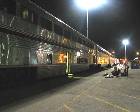 The early arrival at Salt Lake means we have about 80 minutes at the station until our scheduled midnight departure. Unfortunately, this particular area of Salt Lake City is less than desirable, and at 11 o'clock on Sunday night Salt Lake is a ghost town. So, we spend thirty minutes or so taking in the minimal charms of the station and platform area and decide to call it a night.
The early arrival at Salt Lake means we have about 80 minutes at the station until our scheduled midnight departure. Unfortunately, this particular area of Salt Lake City is less than desirable, and at 11 o'clock on Sunday night Salt Lake is a ghost town. So, we spend thirty minutes or so taking in the minimal charms of the station and platform area and decide to call it a night.
While drifting to sleep I think of the trip ahead. We were early into Salt Lake City. We would certainly leave on time. During my pre-trip tracking of the Zephyr's on-time performance, only one train in 55 tries came even close to an on-time arrival at Emeryville, our western terminus. I ponder the chance that we would beat the odds. Would we actually arrive on-time or even early into San Francisco? Is it possible? Maybe pigs can fly! Sleep came before we left Salt Lake City, but that wonderful dream remained until.
Continued in next section
